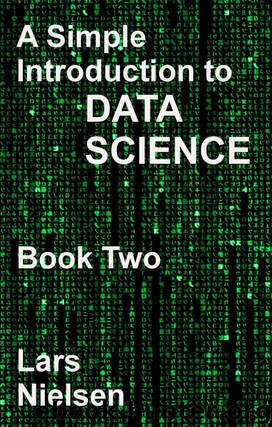A Simple Introduction to Data Science: BOOK TWO (New Street Data Science Basics 2) by Nielsen Lars

Author:Nielsen, Lars [Nielsen, Lars]
Language: eng
Format: azw3, mobi, epub
Publisher: New Street Communications, LLC
Published: 2015-04-07T04:00:00+00:00
5
Artificial Intelligence,
Machine Learning, and
Deep Learning in Data Science
“You can use all the quantitative data you can get, but you still have to distrust it and use your own intelligence and judgment.”
- Alvin Toffler
“The question of whether a computer can think is no more interesting than the question of whether a submarine can swim.”
- Edsger W. Dijkstra
Computers will never replace the intuitive role of the human element vis-a-vis Data Science research. Let me repeat that. Computers will never replace the intuitive role of the human element vis-a-vis Data Science research.
What current and developing Artificial Intelligence (AI) software can and will do, however, is help facilitate the parsing of various dark data, especially dark data which needs to be gathered from such esoteric sources as images and digital recordings of telephone conversations with customers.
AI applications are very good at recognizing and responding to inputs. Ask an AI app linked to an extensive database to give the name of the man who was President during the American Depression, and it will tell you “Franklin Delano Roosevelt.” Posit the speculative question as to whether the Rooseveltian “New Deal” programs sped up or (as some people argue) slowed down the recovery, and the AI application will come up with … nothing.
Speculation, imagination, and conjecture are not attributes which lie within the realm of machines. (A note here. Even fact-based questions can be flubbed by AI apps, depending on the quality and nuance and detail of the data originally input. In training to go on the game show Jeopardy, IBM's “Watson” answered “Wonder Woman” when asked to name the first female to go into space. The data input never separated fictional women from nonfictional women. And the machine was only as good as its data.)
What an AI application – in this example, a natural language processing AI system – can do, however, is take digital recordings of inbound customer-service phone calls and identify all instances of the words “complaint,” “dissatisfied,” and “unhappy,” then match these instances with the words “delivery,” “installation,” and “hot-tub,” to derive data as to what aspects of your hot-tub sales business have annoyed those customers who have wound up annoyed. Data Scientists can then pair this data with other references, such as geographical region, time of year, hot-tub model, and so forth to derive actionable BI. What the computer cannot do is deliver a qualitative analysis based on these quantitative results. For that we need humans.
The machine is, however, capable of dealing with rudimentary fact-based what-if scenarios – scenarios which must first be imagined and conjectured by human Data Scientists posing the right questions upon the right data.
For example, factoring in prescribed mean average temperatures throughout the year as segmented by geographical region, and the minimum temperature necessary for the putty involved with hot-tub installation to settle correctly, and pairing this data with customer complaints related to “installation” segmented by region, where are the dateline “tipping-points” at which installations can best proceed and had best stop in Maine as opposed to Ohio? This type of thing the machine can handle.
Download
A Simple Introduction to Data Science: BOOK TWO (New Street Data Science Basics 2) by Nielsen Lars.mobi
A Simple Introduction to Data Science: BOOK TWO (New Street Data Science Basics 2) by Nielsen Lars.epub
This site does not store any files on its server. We only index and link to content provided by other sites. Please contact the content providers to delete copyright contents if any and email us, we'll remove relevant links or contents immediately.
Algorithms of the Intelligent Web by Haralambos Marmanis;Dmitry Babenko(7852)
Learning SQL by Alan Beaulieu(5412)
Weapons of Math Destruction by Cathy O'Neil(5038)
Big Data Analysis with Python by Ivan Marin(3016)
Blockchain Basics by Daniel Drescher(2891)
Hands-On Machine Learning for Algorithmic Trading by Stefan Jansen(2519)
Pandas Cookbook by Theodore Petrou(2502)
Building Statistical Models in Python by Huy Hoang Nguyen & Paul N Adams & Stuart J Miller(2489)
Mastering Python for Finance by Unknown(2477)
Azure Data and AI Architect Handbook by Olivier Mertens & Breght Van Baelen(2461)
Serverless Machine Learning with Amazon Redshift ML by Debu Panda & Phil Bates & Bhanu Pittampally & Sumeet Joshi(2394)
How The Mind Works by Steven Pinker(2214)
Data Wrangling on AWS by Navnit Shukla | Sankar M | Sam Palani(2177)
Data Engineering with dbt by Roberto Zagni(2063)
Building Machine Learning Systems with Python by Richert Willi Coelho Luis Pedro(2059)
Driving Data Quality with Data Contracts by Andrew Jones(2041)
Network Science with Python and NetworkX Quick Start Guide by Edward L. Platt(1975)
Python Natural Language Processing by Jalaj Thanaki(1892)
Machine Learning Model Serving Patterns and Best Practices by Md Johirul Islam(1841)
